Alexandra Palace: Difference between revisions
Created page with "{{Infobox building |name=Alexandra Palace |county=Middlesex |picture=Alexandra Palace from air 2009 (cropped).jpg |picture caption=Alexandra Palace from the air |os grid ref=T..." |
No edit summary |
||
| Line 13: | Line 13: | ||
|website=[http://www.alexandrapalace.com Alexandra Palace] | |website=[http://www.alexandrapalace.com Alexandra Palace] | ||
}} | }} | ||
'''Alexandra Palace''' is a grand, Victorian entertainment and sports venue in northern [[Middlesex]], standing in | '''Alexandra Palace''' is a grand, Victorian entertainment and sports venue in northern [[Middlesex]], standing in its own park between [[Wood Green]] and [[Muswell Hill]]. It is commonly known by its fond nickname '''Ally Pally'''. | ||
The building is built on the site of Tottenham Wood and the later Tottenham Wood Farm. It is a Grade II listed building.<ref name=nh>{{NHLE|1268256|Alexandra Palace|grade=II}}</ref> | The building is built on the site of Tottenham Wood and the later Tottenham Wood Farm. It is a Grade II listed building.<ref name=nh>{{NHLE|1268256|Alexandra Palace|grade=II}}</ref> | ||
Latest revision as of 14:00, 12 October 2020
| Alexandra Palace | |
|
Middlesex | |
|---|---|
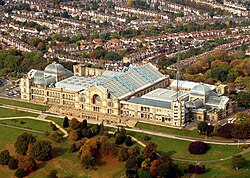 Alexandra Palace from the air | |
| Location | |
| Grid reference: | TQ29589002 |
| Location: | 51°35’39"N, 0°7’51"W |
| History | |
| Built 1865-1875 | |
| By: | John Johnson and Alfred Meeson |
| Information | |
| Owned by: | Alexandra Park and Palace Charitable Trust |
| Website: | Alexandra Palace |
Alexandra Palace is a grand, Victorian entertainment and sports venue in northern Middlesex, standing in its own park between Wood Green and Muswell Hill. It is commonly known by its fond nickname Ally Pally.
The building is built on the site of Tottenham Wood and the later Tottenham Wood Farm. It is a Grade II listed building.[1]
Originally built by the architects John Johnson and Alfred Meeson, Alexandra Palace opened in 1873. It burnt down two weeks after its opening, and was rebuilt by Johnson. Intended as "The People's Palace", its purpose was to serve as a public centre of recreation, education and entertainment; a North Middlesex counterpart to Crystal Palace which stood on the Surrey / Kent border.[2]
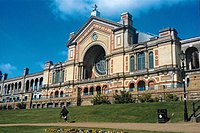
At first a private venture, in 1900 the owners planned to sell it and Alexandra Park for development. A group of neighbouring local authorities managed to acquire it. An Act of Parliament created the Alexandra Palace and Park Trust. The Act required the Trustees to maintain the Palace and Park and make them available for the free use and recreation of the public forever. The present trustee is the local council, whose coat of arms shows lightning bolts depicting the Palace's pioneering role in the development of television.
In 1935, the trustees leased part of the palace to the BBC for use as the production and transmission centre for their new BBC Television. In 1936, it became the home of the BBC's first regular public television service. The broadcasting system was the 405-line monochrome analogue television – the first fully electronic television system to be used in regular broadcasting. Although other facilities soon superseded it after the war, Alexandra Palace continued to be used by the BBC for many years and its radio and television mast is still in use.
The original studios 'A' and 'B' still survive in the southeast wing with their producers' galleries and are used for exhibiting original historical television equipment. The original Victorian theatre with its stage machinery also survives and as of 2019, is back in use. The theatre and stage structure is on English Heritage's Buildings at Risk register. Alexandra Palace became a listed building in 1996,[1] at the instigation of the Hornsey Historical Society.
A planned commercial development of the building into a mixed leisure complex including a hotel, replacement ice-skating rink, cinema, ten-pin bowling alley and exhibition centre, encountered opposition from public groups and was blocked by the High Court in 2007.
The Great Hall and West Hall are typically used for exhibitions, music concerts, and conferences, operated by the trading arm of the charitable trust that owns the building and park on behalf of the public. There is also a pub, ice rink, palm court, and a panoramic view of central London.
In 2013, Alexandra Park was declared a Local Nature Reserve and is also a 'Site of Borough Importance for Nature Conservation', Grade 1.[3]
The nearest railway stations are Alexandra Palace station, with mainline services from Moorgate and the London Underground station at Wood Green on the Piccadilly line. Alexandra Palace is also served by London Buses route W3.
History
19th century
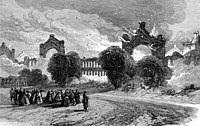
The "Palace of the People" was conceived by the architect Owen Jones in 1859. The Great Northern Palace Company had been established by 1860, but was initially unable to raise financing for the construction of the Palace. Construction materials were acquired and recycled from the large 1862 International Exhibition building in South Kensington after it was demolished: the Government had declined to take it over. In 1863 Alexandra Park Co. Ltd. acquired the land of Tottenham Wood Farm for conversion to a park and to build the People's Palace.[4] Alexandra Park was opened to the public on 23 July 1863.
The planned building was originally named "The Palace of the People"; it and its park were renamed to commemorate the popular new Princess of Wales, Alexandra of Denmark, who had married Prince Edward on 10 March 1863. The Palace of the People, or the People's Palace, remained as alternative names. In September 1865, construction commenced but to a design by John Johnson and Alfred Meeson rather than the glass structure initially proposed by Jones.
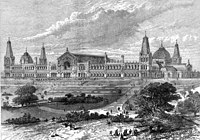
In 1871, work started on the Edgware, Highgate and London Railway to connect the site to Highgate station. Work on both the railway and the palace was completed in 1873 and, on 24 May of that year, Alexandra Palace and Park was opened. The structure covers some seven and a half acres. The palace was built by Kelk and Lucas, who also built the Royal Albert Hall in South Kensington at around the same time.[5] Sims Reeves sang on the opening day before an audience of 102,000.[6]
Only 16 days later, Alexandra Palace was destroyed by a fire which also killed three members of staff. Only the outer walls survived; a loan exhibition of a collection of English pottery and porcelain, comprising some 4,700 items of historic and intrinsic value, was also destroyed.[7]
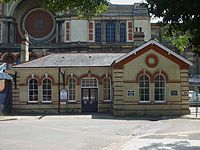
With typical Victorian vigour, the Palace was quickly rebuilt and reopened on 1 May 1875. The new Alexandra Palace contained a concert hall, art galleries, a museum, lecture hall, library, banqueting room and large theatre. The stage of the theatre incorporated machinery which enabled special effects for the pantomimes and melodramas then popular – artists could disappear, reappear and be propelled into the air. The theatre was also used for political meetings. An open-air swimming pool was constructed at the base of the hill in the surrounding park; it is long since closed and little trace remains except some reeds.
The grounds included a horse racing course with grandstand (named Alexandra Park Racecourse and nicknamed the "Frying Pan" and the "Pan Handle" because of its layout), which was London's only racecourse from 1868 until its closure in 1970, a Japanese village, a switchback ride, a boating lake and a 9-hole pitch-and-putt golf course. Alexandra Park cricket and football clubs have also played within the grounds (in the middle of the old racecourse) since 1888. A Henry Willis organ installed in 1875, vandalised in 1918 and restored and reopened in 1929, survives. In its 1929 restored form, Willis's masterpiece was declared by Marcel Dupré to be the finest concert organ in Europe.[8]
20th century
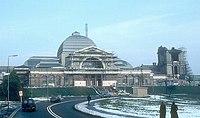
In 1900, the owners of Alexandra Palace and Park were threatening to sell them for redevelopment, but a consortium of public-spirited men in the district, headed by Mr. Henry Burt, JP a member of the Middlesex County Council and of Hornsey District Council, at once embraced the opportunity of securing the palace and the beautiful grounds for the people of London. A committee was formed by Burt and the consortium managed to raise enough money to purchase them just in time. By the Alexandra Park and Palace (Public Purposes) Act 1900, a charitable trust was created; representatives of the purchasing local authorities became the trustees with the duty to keep both building and park "available for the free use and recreation of the public forever".[9]
In 1921 a plaque was erected at the entrance of the south terrace in honour of Burt.[10] It is this duty that the present trustee, the local council, is currently trying to overturn, protesters fear,[11] by selling the building to a commercial developer.[12]
During the First World War the park was closed and the palace and grounds were first used as refugee camp for displaced Belgians, and then later from 1915–19 as an internment camp[13] for German and Austrian civilians.
The theatre was greatly altered in the early 1920s, with the general manager, W. J. MacQueen-Pope, spending the war reparation money on refurbishing the auditorium. He abandoned the understage machinery that produced the effects necessary in Victorian melodrama; some of the machinery is preserved, and there is a project to restore some of it to working order. After these changes, the theatre was leased by Archie Pitt, then husband of Gracie Fields, who appeared in the theatre. Fields also drew an audience of 5,000 people to the hall for a charity event.
In 1935, the trustees leased part of the palace to the BBC for use as the production and transmission centre for their new BBC Television service. The antenna was designed by Charles Samuel Franklin of the Marconi Company. The world's first public broadcasts of (then) "high-definition" television were made from Alexandra Palace in November 1936.[14]
Two competing systems, Marconi-EMI's 405-line system and John Logie Baird's 240-line system, were installed, each with its own broadcast studio and were transmitted on alternate weeks until the 405-line system was chosen in 1937. After the BBC leased the eastern part of the palace the theatre was only used for props storage space.
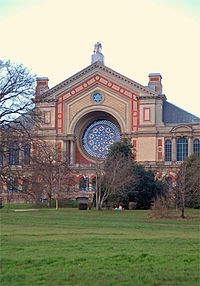
The palace continued as the BBC's main transmitting centre for London until 1956, interrupted only by the Second World War when the transmitter found an alternative use jamming German bombers' navigation systems.[15] In 1944, a German doodlebug]] exploded just outside the organ end of the Great Hall and the Rose Window was blown in, leaving the organ exposed to the elements.[16] In 1947 some of the pieces of the shattered rose window were incorporated in a new design by architect E.T. Spashett during renovation of bomb-damaged public buildings by the Ministry of Works.[17][18]
During the 1940s and 50s the palace also housed a public roller-skating rink and the Alexandra Palace Roller Skating Club.
In the early 1960s, an outside broadcast was made from the top of the tower, in which the first passage of a satellite across the London sky was watched and described. It continued to be used for BBC News broadcasts until 1969, and for the Open University until 1981. The antenna mast still stands and is used for local terrestrial television transmission, local commercial radio and DAB broadcasts. The main London television transmitter is now at Crystal Palace (the site where Ally Pally's former rival stood until it burnt down, not to be rebuilt).
Early in 1980, Haringey council took over the trusteeship of Alexandra Palace, intending to refurbish the building but just six months later, during Capital Radio's Jazz Festival, a fire started under the organ and quickly spread. It destroyed half the building. Again the outer walls survived and the eastern parts, including the theatre and the BBC Television studios and aerial mast, were saved. Parts of the famous organ were destroyed, though it had been dismantled for repairs so some parts (including nearly all the pipework) were away from the building in store. Some of the damage to the palace was repaired immediately but Haringey council overspent on the restoration, creating a £30 million deficit. It was then reopened to the public in 1988 under a new management team headed by Louis Bizat. Later the council was heavily criticised for the overspend in a report by Project Management International.[19]
In 1991, the attorney-general stated that the overspending by the council as trustee was unlawful and so could not be charged to the charity. The council for some years did not accept this politically embarrassing finding and instead maintained that the charity owed the council £30 million, charged compound interest on what it termed a "debt" (which eventually rose to a claim of some £60 million), and to recoup it tried to offer the whole palace for sale — a policy their successors are still trying to carry out despite being rejected by the High Court in October 2007. As of June 2008, it is still unclear whether the council in either of its guises has agreed to write off its 1980s overspend.
An ice rink was installed at Alexandra Palace in 1990. Primarily intended for public skating, it has also housed ice hockey teams including the Haringey Racers, the Haringey Greyhounds, the London Racers and now the Haringey Huskies,[20] as well as a figure skating club, the Alexandra Palace Amateur Ice Skating Club.
21st century
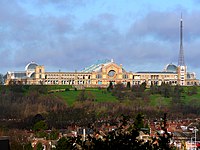
In June 2004, the first performances for about 70 years took place in the theatre, first in its foyer then in July in the theatre itself. Although conditions were far from ideal, the audience was able to see the potential of this very large space – originally seating 3,000, it could not be licensed for more than a couple of hundred. It was intended that the theatre will one day reopen, but much costly restoration would be required first. It will never again reach a seating capacity of 3,000 (not least because one balcony was removed in the early part of the 20th century as a fire precaution, when films started to be shown there). A major season of the theatre company Complicite was planned for 2005 but the project, which would have included some repair and access work, was cancelled due to higher-than-anticipated costs.[21]
Plans by the current trustee, to replace all the charitable uses by commercial ones by a commercial lease of the entire building, including a casino, encountered considerable public and legal opposition, and on 5 October 2007, in the High Court, Mr. Justice Sullivan granted an application by Jacob O'Callaghan, a London resident, to quash the Charity Commission's order authorising a 125-year lease of the entire building to Firoka Ltd.[22]
In 2018 it was announced that the Theatre would open for a BBC Proms performance on 1 September[23] before officially reopening to the public on 1 December 2018 following the completion of the East Wing Restoration Project.[24]
Notable events
Alexandra Palace has hosted a number of significant events over the course of its history. Recurring events held there include the Great British Beer Festival (1977–1980), the Brit Awards (1993–1995), the PDC World Darts Championship (2008–present) and the Masters snooker tournament (2012–present).
In November every year, a large fireworks display is scheduled there as part of Bonfire Night celebrations.
Outside links
| ("Wikimedia Commons" has material about Alexandra Palace) |
- Alexandra Palace (Victorian London)
- Save Ally Pally
- Detailed history of early BBC TV broadcasts
- Alexandra Palace Television Society
- Pictures and Information About Alexandra Palace History
- Hornsey Historical Society
- Friends of Alexandra Park
- Friends of Alexandra Palace Theatre
- Restoration – Alexandra Palace
- History of the Peoples Palace
References
- ↑ 1.0 1.1 National Heritage List 1268256: Alexandra Palace (Grade II listing)
- ↑ O'Connor, John J. (17 November 1986). "TV Reviews; Film Celebrates BBC's 50th Birthday". New York Times. https://www.nytimes.com/1986/11/17/arts/tv-reviews-film-celebrates-bbc-s-50th-birthday.html. Retrieved 8 July 2011.
- ↑ "Alexandra Park". Natural England. 20 March 2014. http://www.lnr.naturalengland.org.uk/Special/lnr/lnr_details.asp?C=17&N=&ID=1770. Retrieved 9 April 2014.
- ↑ "A Brief History of Alexandra Palace and Park". Hornsey Historical Society. January 2018. https://hornseyhistorical.org.uk/brief-history-alexandra-palace-park/. Retrieved 13 June 2018.
- ↑ Charles Thomas Lucas at Oxford Dictionary of National Biography. Oxford Dictionary of National Biography. 2004. doi:10.1093/ref:odnb/49439. http://www.oxforddnb.com/view/article/49439. Retrieved 8 July 2011.
- ↑ Pearce, Charles E. (1924). Sims Reeves: Fifty Years of Music in England. London: Stanley Paul. p. 307.
- ↑ Arthur Hayden, Spode and His Successors (Cassell, London 1925), pp. 12, 90.
- ↑ Felix Aprahamian, The Alexandra Palace Organ, Sleevenote to HMV HQM 1199 (Hayes 1970).
- ↑ "Our History". alexandrapalace.com. http://www.alexandrapalace.com/about-us/our-history/. Retrieved 7 June 2018.
- ↑ "Henry Burt". https://www.londonremembers.com/memorials/henry-burt. Retrieved 1 December 2018.
- ↑ "saveallypally.com". saveallypally.com. 1 June 2007. http://www.saveallypally.com. Retrieved 8 July 2011.
- ↑ Ham & High
- ↑ "Alexandra Palace's war time efforts to be showcased in new app and video | Middlesex University London". http://www.mdx.ac.uk/news/2013/10/alexandra-palaces-war-time-efforts-to-be-showcased-in-new-app-and-video.
- ↑ Burns, R.W. (1998). Television: An International History of the Formative Years. London: The Institution of Electrical Engineers. p. ix. ISBN 978-0-85296-914-4.
- ↑ "Timeline". alexandrapalace.com. http://www.alexandrapalace.com/timeline/. Retrieved 7 June 2018.
- ↑ Aprahamian 1970, loc. cit.
- ↑ National Ar4chives: Records of the successive Works departments, and the Ancient Monuments Boards and Inspectorate, Ministry of Works, 1943–1962
- ↑ Archives of E.T. Spashett ARIBA
- ↑ Project Management International plc, Alexandra Palace: Report for the London Borough of Haringey (1990)
- ↑ Harris, Martin C. (2005). Homes of British Ice Hockey. History Press. p. 116. ISBN 978-0752425818.
- ↑ Gillespie, Ruth (8 February 2005). "Complicite scraps plans for Alexandra Palace rebirth". The Stage News (The Stage). http://www.thestage.co.uk/news/newsstory.php/6411/complicite-scraps-plans-for-alexandra-palace. Retrieved 25 June 2008. "The company had announced plans for a £500,000 refurbishment of the 19th century building last year, more than 65 years after the venue went dark and planned to occupy the space for 12-weeks in the spring. However, Complicite has been forced to abandon its proposals after the cost of essential safety work on the 2,500-seat auditorium shot up from £160,000 to £310,000."
- ↑ Court rejects £55m Palace plans
- ↑ "Sierra Boggess to star in West Side Story at BBC Proms". The Stage. 19 April 2018. https://www.thestage.co.uk/news/2018/sierra-boggess-to-star-in-west-side-story-at-bbc-proms/.
- ↑ Brown, Mark (26 April 2018). "Alexandra Palace's 'hidden' theatre to reopen after £18.8m restoration". https://www.theguardian.com/stage/2018/apr/26/alexandra-palaces-hidden-theatre-to-reopen-after-188m-restoration.
